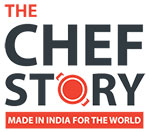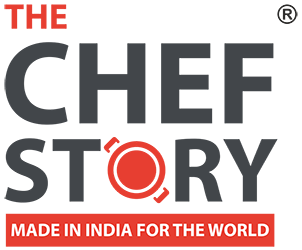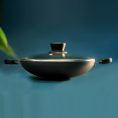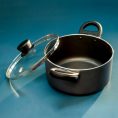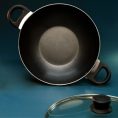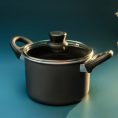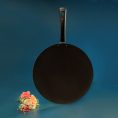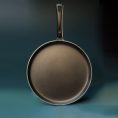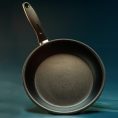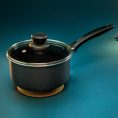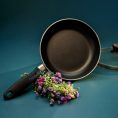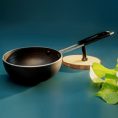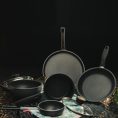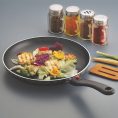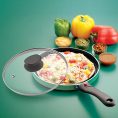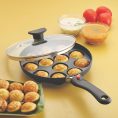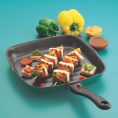Chefs and cooking wizards may know how different kinds of utensils, with their varying shapes and sizes, play a vital role in preparing the perfect dish.
As it is said, cooking is an art form, and just like any painter who needs different types of brushes to create a masterpiece, a chef requires different shapes and sizes of cooking pans to make the perfect dish.
If you tend to cook in a deeper utensil, it may completely change the taste of the food as compared to cooking in a shallow pan.
There is a seemingly endless variety of pots and pans to cook with. However, by simply looking at what each type of pot or pan is best suited for, you can make a much more educated decision about which vessel to use when preparing your next breakfast, lunch or dinner at home.
As per Chef Gurpreet Singh form Punjab Grill, “it completely depends on what you are cooking and which process you use. For sauteing and pan grill, we always use shallow pans, whereas on the other hand, braising and stewing are done in deeper pots as juices are retained in the cooking pot to make the dish more flavourful.”
According to the book, Diet & Nutrition, A Holistic Approach by Rudolph Ballentine, the metal of which a utensil is made is not only an important variable, the shape of a pot or pan is also a consideration and has a great deal to do with the way food cooks. Deeper pots tend to hold moisture inside and keep much of the cooking food submerged. Foods cooking in the center of a huge vessel undergo a more constant temperature and somewhat increased pressure, which further help keep the food moist. In a shallow utensil, since the food is exposed to air and evaporation, moisture is lost more easily than in deeper pots and food may cook drier.
Deep Pot Cooking
In deep pot cooking, the high edges of the deep pot allow heat to spread across evenly rather than just from the bottom. Methods like braising, stewing, broasting, boiling and steaming are used in deep cooking. Chefs use deep pots majorly for liquids, such as making soups or boiling water for pasta or noodles. If sauteing is attempted in a deep pot, the high sides prevent moisture from escaping and the food tends to cook ‘wet’. Large quantities of food are generally prepared in deep dishes or utensils, which results in different taste and flavour as compared to those produced when a small amount is made. In most Indian households you will see people using huge Dekchis, Bhagonas or huge clay pots to cook food that needs a longer period of cooking at low temperature. Biryanis among others make great dishes to cook in deep pots.
Shallow Pot Cooking
In shallow pan cooking, the wide base and shallow sides of the pan allows the food to cook evenly and quickly. Pans are majorly used for frying and baking foods. Foods like pancakes, chapattis among others are well prepared in shallow pans. Shallow cooking includes foods like Paneer Tikkas, Aloo Tikki and so much more. If you believe more in less oil and shallow frying, then shallow cooking pans are the best for you. Also, vegetables that have some amount of water content naturally can be cooked in shallow pans as they do not need extra moisture. To simplify, there are only four ways to cook proteins:
- Direct heat methods: which include Sauteing, Stir-fry, Grilling, Broiling and Frying.
- Indirect heat methods: which mean roasting and baking.
- Wet heat methods: including steaming, boiling, poaching, stewing and braising.
- Microwaving
- SAUTEING: (SKILLET OR SAUTE PAN)
To sauté is to cook food quickly in a minimal amount of fat over relatively high heat. The word comes from the French verb sauter, which means “to jump,” and describes not only how food reacts when placed in a hot pan but also the method of tossing the food in the pan in a small amount of fat over moderately high heat without frequent stirring―just flipping it over when one side is browned. The browning achieved by sautéing lends richness to produce. And because the food is cooked quickly, the integrity of the flavor and texture remains intact; asparagus, for example, retains its slightly grassy punch, as well as a pleasing crisp-tender bite.Use either a skillet (a wide pan with sloped sides) or sauté pan (a wide pan with straight sides) for this technique. Both have a large surface area, so food is less likely to become overcrowded.
- STIR-FRY: (WOK)
Stir-frying and sautéing are techniques that share some similarities. Both methods cook food quickly in a small amount of fat. But stir-frying cooks food over intensely high heat, stirring constantly. Sautéing involves only moderately high heat, and the food is not in continuous motion. - GRILLING: (GRILL PAN)
Grilling is a form of cooking that involves dry heat applied to the surface of food, commonly from above, below or from the side. Grilling usually involves a significant amount of direct, radiant heat, and tends to be used for cooking vegetables quickly. Food to be grilled is cooked on a grill (an open wire grid such as a gridiron with a heat source above or below), using a cast iron/frying pan, or a grill pan (similar to a frying pan, but with raised ridges to mimic the wires of an open grill).Although barbecuing and grilling both refer to cooking food outdoors over a heat source, they aren’t interchangeable terms for the same cooking technique. The most important factors that differentiate the two are the type of heat used and the total cook time. When you barbecue you are cooking with a slow circumvented unit of hot air with the lid closed. Grilling is done with the lid up and you’re cooking with direct heat on the bottom, instead of all around the source. - BROILING: (BROILER OVENS)
Broiling is not direct heat but cooking via infrared radiation. However, the heat source is extremely hot and in close proximity to the food. Thick items are not appropriate for broiling. Again, you will obliterate the outside by the time the center is cooked.Long story short, grilling and broiling refer to a similar cooking process with only one major difference. When grilling, the heat source is below (like with a barbecue grill), but in oven broiling, the heating source is above. Both grilling and broiling involve intense direct heat.
- FRYING: (SHALLOW FRYING-SKILLETS, GRIDDLES, DEEP FRYING-KADAI)
From chips and doughnuts to French fries and Onion rings, fried food is hard to resist. And it’s no wonder: No other cooking method delivers such crisp, delicious browning while keeping food moist and tender on the inside. But frying can be tricky, and doing it well requires not only good technique but also an understanding of the science behind it. Here’s what you need to know to fry right.How does frying work?Any food cooked in hot fat is fried. The method of heat transference is the same whether there’s just a little fat in the pan (sautéing), the fat comes partway up the sides of the food (shallow-frying), or the fat completely envelops the food (deep-frying). When food is added to hot oil (usually 350°F to 375°F), its surface dehydrates. Meanwhile, through a series of Maillard reactions (named after the chemist Louis Camille Maillard), its sugars and proteins break down to create complex flavor and golden-brown color.Browning is quick and thorough because the hot liquid fat delivers heat to even the smallest crevices on a food’s surface. In the initial moments of frying, as the surface dehydrates, it forms a crust that inhibits further oil absorption, while continuing to conduct heat to the interior of the food, where the heat causes starches to gelatinize (as in french fries),and fibers to soften (in fried zucchini).Maintaining the correct oil temperature is key to frying. If the temperature drops too low, the crust forms slowly, allowing the food to absorb more fat and become greasy. If the oil gets too hot, the food burns on the surface before it cooks through.
Similar to sautéing, pan-fried foods are generally turned over once or twice during cooking, using tongs or a spatula, while sautéed foods are cooked by “tossing in the pan”
In all of these methods:
- the food should be at room temperature at the onset of cooking,
- heat the cooking vessel and/or oil fully before introducing the food,
- do not move the food until the one side has seared, and
- brushing the food lightly with oil before cooking will facilitate even browning.
Searing (or pan searing) is a technique used in which the surface of the food is cooked at high temperature until a browned crust forms.
Browning (Same as searing)
Effects of the Maillard reaction on a starch-rich material (potato slice). The substrate is shown before (left) and after (right) being exposed to hot dry air (503 K, approx. 230 °C/445 °F).
- ROASTING: (CONVECTION OVEN)
The method of choice for large items. The heat in an oven is provided by convection, i.e., circulating air currents. Convection, not being direct heat, is less harsh. Foods can roast for extended periods of time and be cooked to perfection inside and out, assuming the correct temperature is maintained.Generally, the larger the item, the lower the roasting temperature. Given the correct temperature, all you need to do is place the food in the oven and let nature take its course. However, some chefs prefer to boost the heat temporarily at the beginning or the end of the cooking to ensure a good sear. If this is your plan, you’re better off spiking the heat near the end.Moreover, you should always have a thermometer handy to check the internal temperature of the food.Roasted veggies — like crispy brussels sprouts, crunchy cauliflower or caramelized root vegetables — can taste like a guilty pleasure, almost too tasty to really be good for you. But nutritionists assure that even though subjecting vegetables to intense heat can alter their nutritional profile and may compromise some nutrients, it can boost others.Cooking vegetables does lower levels of some nutrients, especially water-soluble vitamins like C and some B vitamins. But it’s a trade off, because cooking can also make some nutrients easier for the body to absorb. Cooked tomatoes, for example, provide higher levels of lycopene, which may have cardiovascular benefits and cooked carrots have higher levels of carotenoids, rich in antioxidants.
- BAKING: (CONVECTION OVEN)
Baking is a method of preparing food that uses dry heat, normally in an oven, but can also be done in hot ashes, or on hot stones. The most common baked item is bread but many other types of foods are baked. Heat is gradually transferred “from the surface of cakes, cookies, and breads to their center. As heat travels through, it transforms batters and doughs into baked goods and more with a firm dry crust and a softer centre.The balancing act with dry heat methods is to cook the center of your food to the proper doneness before the outside burns. The larger the item, the more likely the exterior will burn before the heat has penetrated the center sufficiently. We want to sear the surface of our food, not burn it. - BRAISING: (DUTCH OVEN)
Braising (from the French word braiser) is a combination-cooking method that uses both wet and dry heats: typically, the food is first sautéed or seared at a high temperature, then finished in a covered pot at a lower temperature while sitting in some (variable) amount of liquid (which may also add flavor). - STEWING: (SAUCE PAN, DUTCH OVEN)
A stew is a combination of solid food ingredients that have been cooked in liquid and served in the resultant gravy. Ingredients in a stew can include any combination of vegetables (such as carrots, potatoes, onions, beans, peppers, mushrooms and tomatoes). While water can be used as the stew-cooking liquid, stock is also common. Seasoning and flavourings may also be added. Stews are typically cooked at a relatively low temperature (simmered, not boiled), allowing flavours to mingle.
- FRYING: (SHALLOW FRYING-SKILLETS, GRIDDLES, DEEP FRYING-KADAI)
They are all moist-heat cooking techniques that adhere to the basic steps of immersing food in a liquid in order to complete its cooking process. The three cooking techniques are differentiated by temperature level.Since the level of heat varies between the three stages, certain food items are more conducive to one technique over another. The liquid used also varies depending upon the temperature since items like milk should be kept at a low temperature to prevent scorching or boiling over.While it might seem simple to differentiate between these three fundamental cooking techniques, each one has its positives and negatives. Once you understand what these are, you will be well on your way to moist-heat cooking success.Poaching:
Poaching is a gentle way to cook delicate foods such as fruit, tender vegetables. The temperature ranges from between 60–180°F (upto 80°C) and since the heat is relatively low, liquids such as milk, stock, oil, and wine are all suitable for poaching. Because food items that are suitable for poaching cook in a relatively short period of time, they are able to retain their color, flavor, and nutritional value in a way that foods that are simmered or boiled are not.Simmering:
Simmering occurs between 180-200°F (upto 90°C). Dishes such as stews, stocks, sauces, soups, and items like pasta, potatoes, and rice are all perfect dancing partners for simmering. Since these recipes and ingredients generally take longer to cook than those that are poached, flavor, color, and nutritional value are sometimes diminished. However, since simmering enables the flavors and ingredients in dishes such as soups and stews to mingle for a substantial period of time, simmering is also the ideal way to create new flavors.Fine simmering occurs when tiny bubbles rise to the surface of the water every two to four seconds. Standard simmering takes place when bubbles are rising consistently and vigorous simmering happens when there are consistent bubbles accompanied by steam.
Boiling
Boiling occurs once the temperature of the liquid exceeds 212°F. Adding sugar or salt to the liquid increases its boiling point and because it typically takes less time to cook an item by boiling it, more flavor, color, and nutrients are retained than when simmering. Boiling is also a safe way to prepare a food item since the high temperature kills off dangerous microbes, bacteria, and parasites that might exist. Tender cuts of meat, root vegetables, and tougher grains like barley are all suitable for boiling. - STEAMING: (STEAMER, PRESSURE COOKER)
When you boil something it’s at least mostly immersed in the cooking medium, usually water, which is heated to its boiling point. How your mom probably cooked the potatoes before mashing them.When steaming food, it never actually touches the boiling water but is suspended above it in the same vessel. The steam from the boiling water cooks the food. Steaming preserve a lot of the flavor that gets discarded with the water when you boil it. E.g. idli preparationFor a flavor experiment, boil some broccoli florets and steam some. Decide which you like better. Try the same thing with asparagus spears and with cauliflower florets. You’ll be amazed with the way the different cooking methods affect the flavor.Steamed Rice vs. Boiled Rice: Which Is Good for Health?Boiled rice’s main benefit is a lower starch content. If you’re trying to cut down on your carbohydrate or calorie intake, wash the rice a few times until the water runs clear, boil it and drain away the excess water when you’re done to get rid of some of the starch. However, this method is not ideal, because it causes boiled rice to lose its nutrition.
Alternatively, you can steam the rice or boil it with the exact amount of water required, in order to help the boiled rice retain its nutrition. You can also opt for a combination of the two methods, where you boil it first and then switch off the heat to let it steam.
